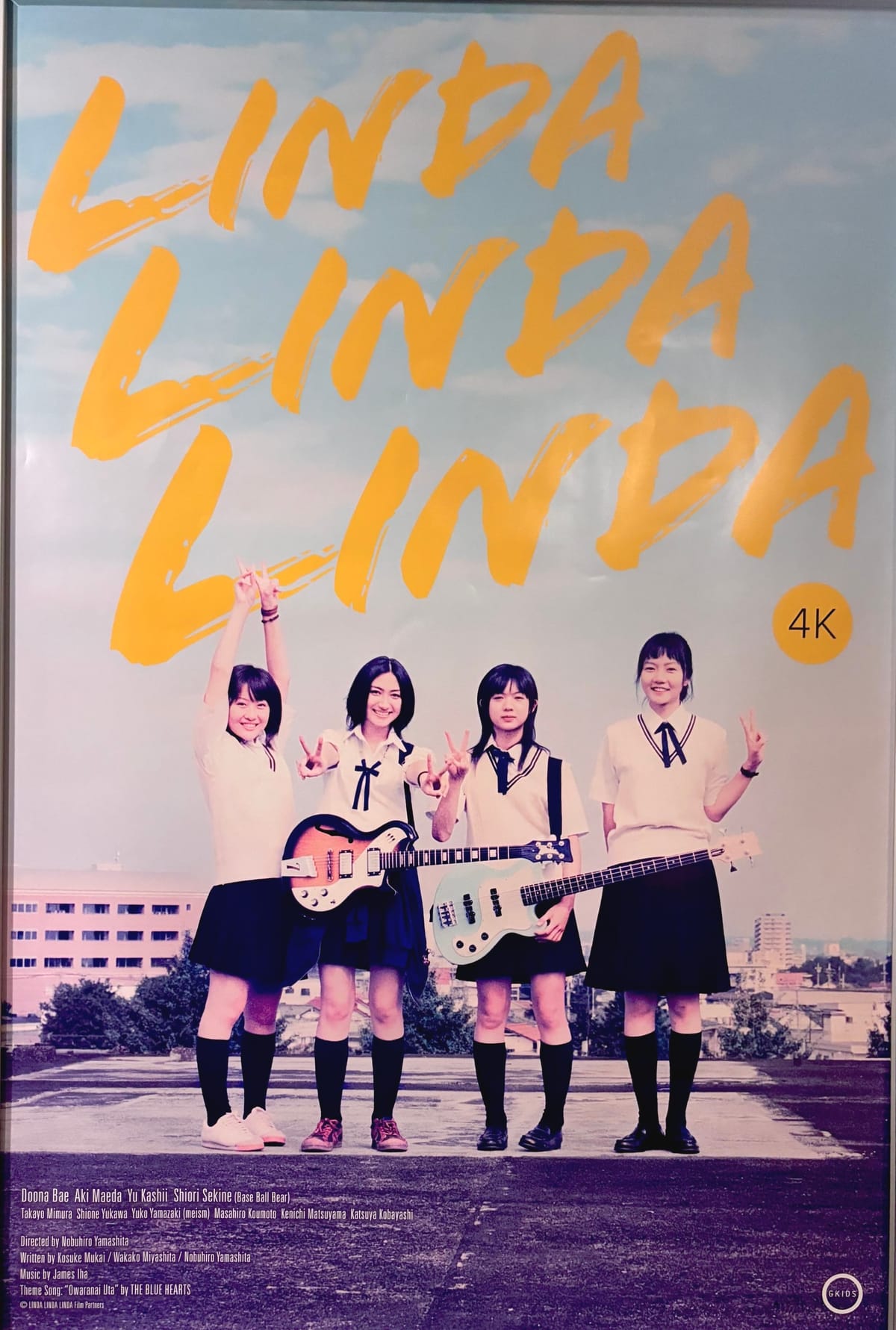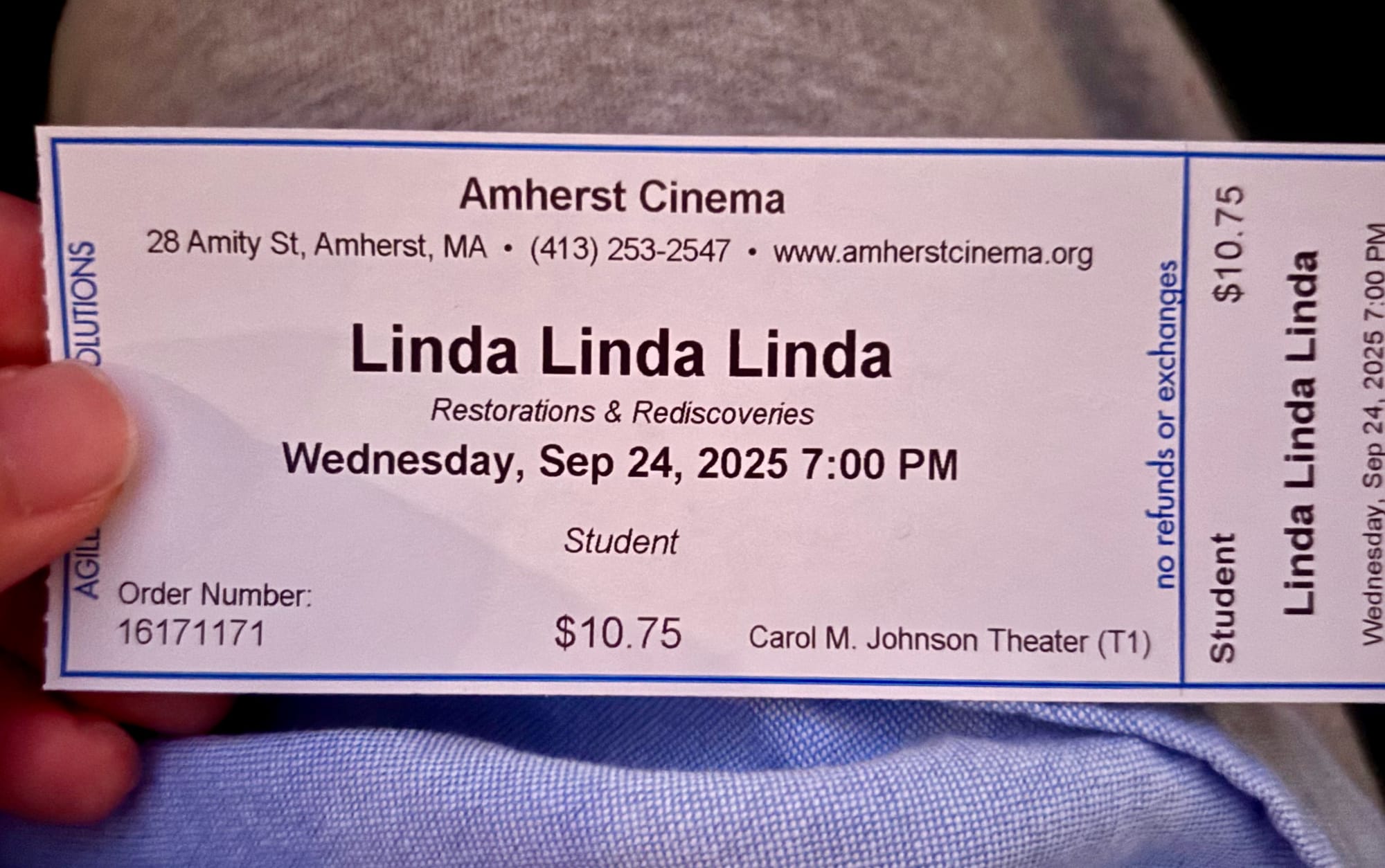Adorable, Awkward, Punk or “Linda Linda Linda?”
What happens when a group of schoolgirls tries to pull off a punk rock performance with only three days to prepare? In his review of “Linda Linda Linda,” Senior Managing Editor Edwyn Choi ’27 describes how the film turns teenage chaos into a feel-good love letter to high school and Japanese rock.

“Adorable” is not the first word I’d use to describe any film, let alone one about a band of high schoolers. And yet “adorable” is absolutely the adjective that captures Nobuhiro Yamashita’s 2005 comedy-drama film, “Linda Linda Linda.”
The film follows a band of schoolgirls who lose two of their members just three days before they’re due to perform at the school’s music festival. The guitarist has injured her finger, while the lead singer has quit after an argument with the keyboardist. Even with just three members remaining — the keyboardist, Kei (Yuu Kashii); the drummer, Kyoko (Aki Maeda); and the bassist, Nozomi (Shiori Sekine) — the group still decides to play at the concert, opting to cover three songs from the Japanese punk rock band, The Blue Hearts.
The band picks the first girl they can find to replace their lead singer, who happens to be Son (Bae Doona), an exchange student from South Korea; meanwhile, Kei decides to learn the guitar in three days. The rest of the film follows the newly formed band as the members rush to practice and perfect their new songs.
But summarizing the film’s plot doesn’t do it much justice. In fact, this film is about anything but perfection. It involves awkward crush confessions, late-night rehearsals, and missed practices — all done with a surprising amount of charm.
One of the funniest scenes in the film takes place around the middle: a Japanese student tries to confess his love in Korean to Son, who at first fails to understand him due to his poor pronunciation. When Son finally realizes what’s happening, she awkwardly rebuffs him and runs away. There are other scenes that are more heartfelt than funny, such as when the band first practices together, only for them to giggle when they hear how terrible they sound. While the band is onstage near the end of the film, Son decides to name the group Paranmaum (Korean for The Blue Hearts) without having told any of the band members ahead of time, leading to confusion onstage and laughter in the movie theater I was in.

If the film’s title hasn’t indicated anything, “Linda Linda Linda” is not only a comedy about the awkwardness of high school viewed through a nostalgic lens, but a love letter to the Japanese punk rock era of the ’80s and ’90s as well, even if it ostensibly takes place in 2005.
The film’s title is borrowed from a song in the self-titled debut album by “The Blue Hearts”, which Rolling Stone Japan ranked third on its list of “100 Greatest Japanese Rock Albums of All Time.” Paranmaum covers three songs in the film: “Linda Linda,” “Boku no Migite (My Right Hand),” and “Owaranai Uta (Never Ending Song).” While the film’s soundtrack is on Spotify (including the three covers), The Blue Hearts’ original songs aren’t, meaning YouTube might be your best option if you want to listen.
Despite its tenderhearted and funny tone, the film intermittently takes on a more bittersweet tone. Its prologue opens with raw video footage of a student at the festival telling the viewer, “We can’t let anybody tell us that when we are no longer children, that we become adults! We don’t stop being children at heart. Where are we really going to be? Are things really going to be okay like this?”
Most of the film’s dramatic scenes come from keyboardist-turned-guitarist Kei’s unresolved conflict with Rinko (Takayo Mimura), who was the former vocalist Son replaced. Rinko and Kei occasionally run into each other throughout the film, up until just before Paranmaum’s performance, which leads to several key moments of tension. While these scenes are always sandwiched between funnier moments, the viewer might be left unsatisfied with the way the film handles (or doesn’t handle) the Kei-Rinko conflict. The film’s final moments leave a rather bittersweet ending, especially when several characters throughout the film have reminded the viewer that Kei was the reason Rinko left the band.
Other than these intermittent scenes, however, the film is best described as a comedy with lots of heart — even in some of the less lighthearted scenes (the words “sad” and “sadder” don’t really fit this film), the characters and film maintain a cheerful tone.
While this mostly-unexplored bittersweet undertone feels somewhat like a missed oversight during the writing process, it also helps ground the film in reality, giving the film its sincere yet funny tone — not once does it ever effect a cartoonish level of lightheartedness.
For those who are worried that the film will depend too much on its music for its emotional highs (that is, it becomes more of a musical than a dramedy), no need to worry. “Linda Linda Linda” manages to maintain its emotional appeal without necessarily depending on the music to deliver those emotions. Its characters all maintain an unshakeable charm even outside the band room, although you’ll be searching for the film’s music long after the credits roll.
Granted, while the film certainly isn’t on “KPop Demon Hunters” (2025) or “Bohemian Rhapsody” (2018) levels of superficiality, it also plays things pretty safe. This isn’t “La La Land” (2016) or “O Brother, Where Art Thou?” (2002). But for what “Linda Linda Linda” is doing — writing a tender love letter to Japanese punk rock and our nostalgic high school days — it hits all the right notes.





Comments ()